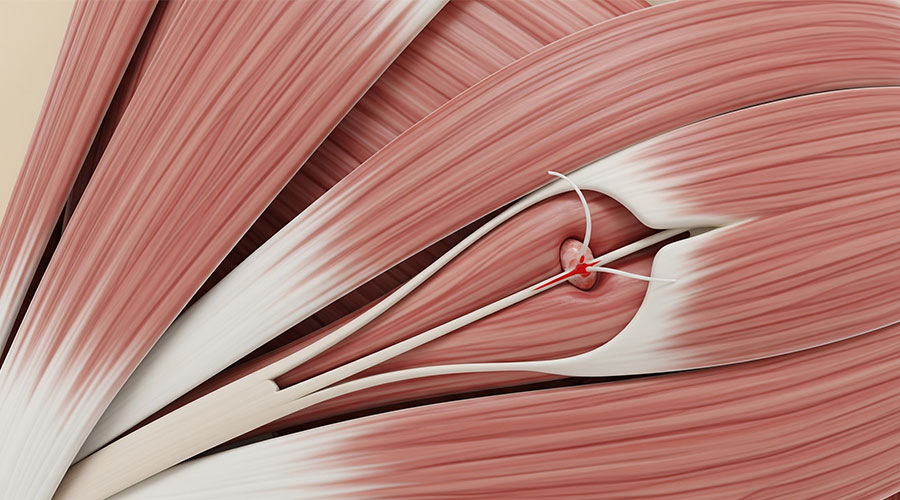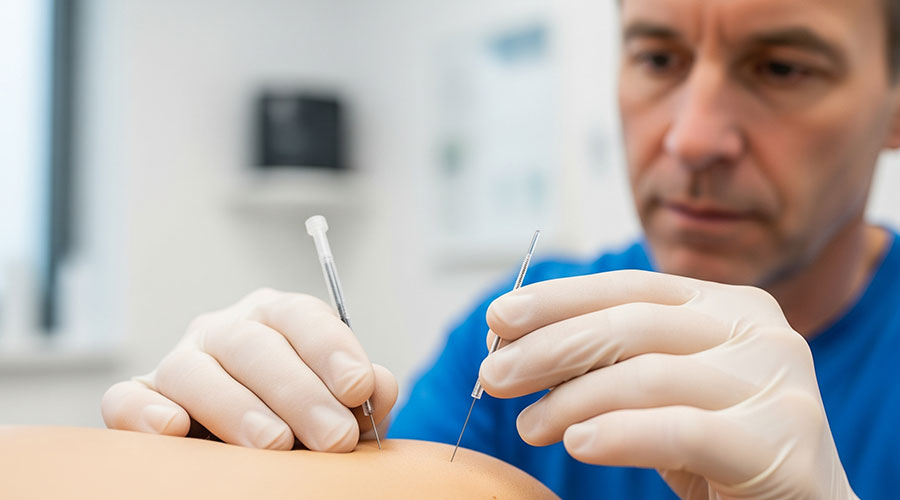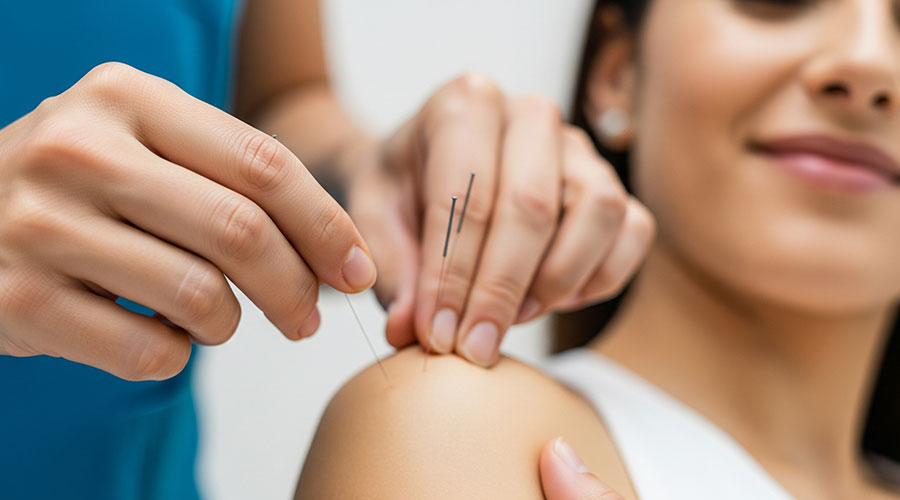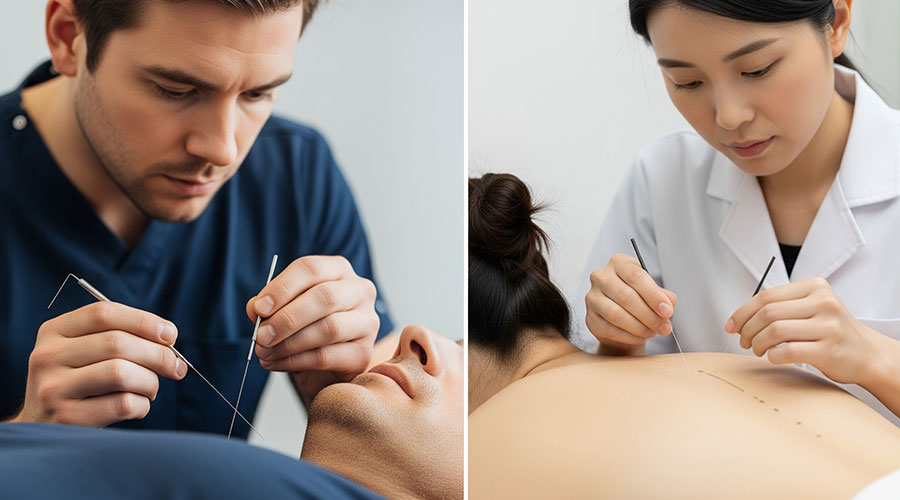When there are consistant trigger points in the muscles, when manual therapies and Graston techniques are not giving you relief- we recommend a technique that could be extremely beneficial to our patients. It is called Dry needling or electrodryneedling. As a modern, evidence-based technique used by physical therapists and other trained healthcare professionals, dry needling offers a powerful solution for targeting the source of many musculoskeletal trigger points, trigger point therapy, tendinipathies, and peripheral neuropathy.
This comprehensive guide, created to provide you with helpful, reliable, and people-first information, will walk you through everything you need to know. We'll explore what dry needling is, how it works, the conditions it treats, and what you can expect during a session. This article is designed to empower you to have an informed conversation with your healthcare provider, not to replace professional medical advice.
First, What Is a Myofascial Trigger Point?

To understand dry needling, you first need to understand what it targets: myofascial trigger points.
A trigger point is essentially a deep muscular painful"knot" or a tight band within a muscle. These knots can be painful to the touch and can disrupt the muscle's normal function, leading to stiffness, pain, and referred pain.
- Causes: Trigger points can develop from stress, injury, overuse (like from sports or repetitive work tasks), or poor posture.
- Referred Pain: A key characteristic of a trigger point is its ability to cause "referred pain"—pain that shows up in a different part of thebody. For example, a trigger point in your shoulder muscle might cause a headache.
- Types: They can be active (currently causing pain) or latent (not painful now, but can become active).
How Does Dry Needling Work?

Dry needling is a therapeutic technique where a physical therapist inserts a thin, solid, "dry" filiform needle into a trigger point. The needle is called "dry" because it doesn't inject any medication or substance into the body.
The process works through several mechanisms:
Eliciting a Local Twitch Response (LTR): When the needle accurately stimulates a trigger point, it often causes a brief, involuntary spasm or "twitch" in the muscle fiber. This LTR is a crucial part of the therapy, as it helps to "release" the knot, decrease muscle contraction, and reduce chemical irritation.
Restoring Blood Flow: The twitch response helps to relax the tight muscle bands, which in turn improves blood circulation to the area, bringing oxygen and nutrients needed for healing.
Releasing Natural Painkillers: This needle insertion causes a production of Enkaphalans and Endorphins ( body’s natural pain-killers). The stimulation may also The ultimate result is a reduction in pain, decreased muscle tension, and improved flexibility and range of motion.
What Conditions Can Dry Needling Treat?
Dry needling is a versatile treatment that can be part of a comprehensive care plan for a wide range of acute and chronic conditions, including:
Cervicalgia ( neck pain) related muscle spasms and trigger points
Shoulder tendinopathy
T.M.J and masseter trigger point
Tension headaches and migraines
Lower back muscle spasms and strains
Sciatica and disc issues
Tendonitis and other repetitive use injuries (e.g., Carpal Tunnel Syndrome)
Joint problems (e.g., hip and knee pain)
Whiplash
Fibromyalgia
The Key Benefits of Dry Needling
- When performed by a trained professional, dry needling offers significant advantages:
- Fast & Effective Pain Relief: Many patients experience an improvement in their pain and mobility almost immediately or within 24-72 hours.
- Targets Deep Tissues: It can effectively reach deep muscle tissues that are difficult to target with manual therapy.
- Fewer Sessions: Often, positive results can be achieved in just a few sessions (typically 1-5).
- Safe & Minimally Invasive: It is a very safe procedure with minimal side effects when performed by a qualified physical therapist.
- Cost-Effective: It is an affordable treatment compared to more invasive options like surgery.
The Dry Needling Procedure: What to Expect

Understanding the process can help alleviate any concerns you might have.
Who Performs It? Dry needling is performed by licensed physical therapists or Doctor of Chiropractic, and other healthcare professionals who have completed extensive post-graduate training in anatomy, safety, and needling techniques.
Before the Session: Your therapist will conduct a thorough physical examination and review your medical history to ensure you are a good candidate.
During the Session:
You'll be positioned comfortably, often wearing loose clothing.
The therapist will sterilize the skin over the treatment area and locate the trigger point by touch (palpation).
Using a sterile, single-use, thin needle, the therapist will gently tap it into the skin and advance it toward the trigger point.
The needle may remain in place for a few seconds or up to 20 minutes. The therapist might also use a "pistoning" (in-and-out) technique to elicit multiple twitch responses.
After the Session: It's important to drink plenty of water and follow any home exercise or stretching instructions provided by your therapist.
Does Dry Needling Hurt?
This is one of the most common questions. The experience varies, but here’s a general guide:
Sensation: You might feel a slight sting or prick as the needle enters the skin. When the needle reaches the trigger point, you may feel a dull ache, a cramping sensation, or the characteristic "twitch." This twitch, while sometimes uncomfortable, is a sign that the treatment is working effectively.
Post-Treatment Soreness: It is very common to experience muscle soreness, stiffness, or aching in the treated area for 24-36 hours afterward, similar to how you might feel after an intense workout. Bruising is also possible. Continuing to move and gently stretch the muscle can help alleviate this.
Who Shouldn't Get Dry Needling? (Contraindications)

While very safe, dry needling is not appropriate for everyone. You should avoid this treatment if you:
Are pregnant (especially in the first trimester).
Have a severe fear of needles (trypanophobia).
Are taking blood-thinning medication.
Have a compromised immune system or an active infection.
Have recently had surgery in the area.
Are a child under 12.
Side Effects and Risks
The most common side effects are mild and temporary:
Soreness and aching at the needle site.
Bruising.
Fatigue or feeling light-headed.
Serious risks are extremely rare when the procedure is performed by a properly trained professional. The most significant rare risk is a pneumothorax (collapsed lung) if needling is performed in the chest area. This highlights the critical importance of choosing a therapist with specialized training and a deep understanding of human anatomy.
Dry Needling vs. Acupuncture: What's the Difference?

Accupuncture is a Chinese/ oriental eastern medicine , and does not treat the muscular trigger point. Dryneedling is designed to be inserted inside the active muscle trigger point only.
Conclusion: Is Dry Needling Right for You?
Dry needling and electro-dryneedling could be beneficial to most individuals with an active trigger point presentations. There are some contraindications : hemophilia, hypertension, DVT, epilepsy, and some neurological disorders. It is recommended to receive a conservative treatment at first, and then go deeper with the needling in the future sessions.
Important Recommendation: Always consult with your doctor or a qualified physical therapist to determine if dry needling is the right treatment for your specific condition.



